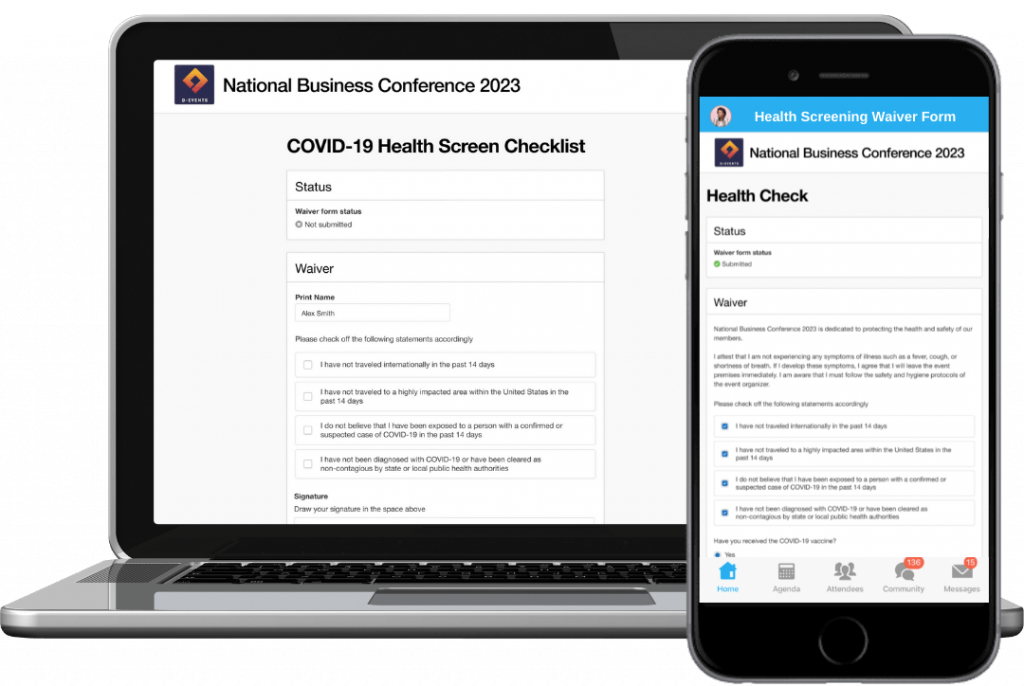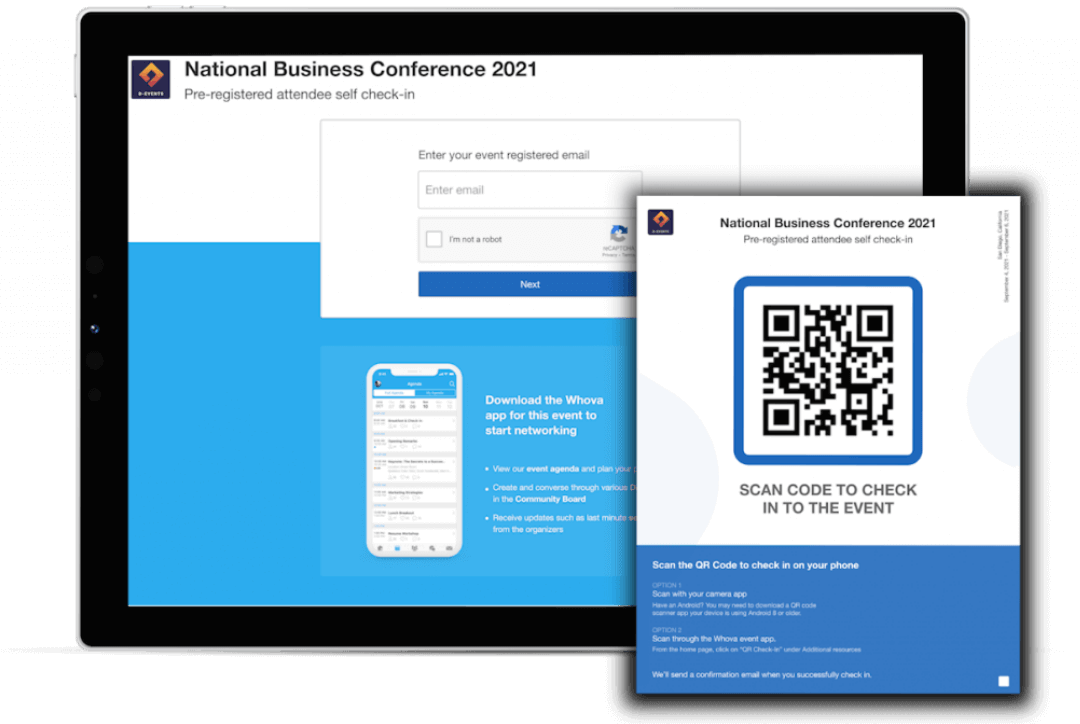In-Person Events Are Going to Look Different
Your Guide to Going Back
We’ve all missed in-person events, which is why it’s so exciting to see them returning. While many events will remain virtual and hybrid for at least a while longer, there are lots of in-person events on the horizon: in fact, 76% of event planners hope to return in person in 2022.
But returning in person doesn’t necessarily mean a return to “normal”. The bad news? Organizers will be facing new challenges with venue, budget, and safety. The good news? By making use of some of the lessons and strategies from virtual events, we might be seeing in-person events that are stronger, more engaging, and more accessible than ever.
If you’re thinking about bringing your next event back in person, here’s what you should know about how they’ll be different, and what you should plan for going forward.
Leveraging safety strategies from other organizers
Planning a safe event is going to be one of your most important concerns, as well as one of the biggest changes from pre-COVID events. Not only do you want to make sure all of your attendees stay safe and healthy, but attendees will be more likely to attend in the first place if they know you have regulations that will keep them safe.
There are a few major safety measures you might already be considering for your event, such as:
- Completing temperature checks at the door
- Requiring proof of vaccination or a negative COVID test from all attendees
- Requiring masks and providing them onsite for attendees
Beyond that, there are plenty of other ways you can make your event safer — here are some tips from past in-person event organizers. (We’ve highlighted a few of our favorites.)
- Conducting self check-in to reduce contact with staff
- Using a “sticker code” with each color indicating an attendee’s boundaries (e.g. Green = comfortable unmasked, yellow = masked, red = masked and distanced)
- Giving staff a separate room to set up to reduce contact
- Having sponsors donate hand sanitizers branded with their logo
- Asking attendees to schedule their visits to exhibitors to manage booth traffic
- Adding extra space between booths to create larger aisles
- Serving plated meals instead of a buffet (this can also be cheaper!)
- Deep cleaning rooms between sessions and keeping windows open
But no matter what rules you decide on, they’re no good if you don’t have a reliable way of enforcing them. Make sure your event staff knows what rules attendees are expected to follow and that they’re ready and willing to jump in and make sure everyone is behaving accordingly. You should also be communicating these rules to attendees well before the event and can set up signs around the venue to remind them.
Asking venues the right questions
If you’ve ever organized an event before, you know that finding the right venue can be its own challenge, and this year, it’s going to be a major part of planning a safe event.
Depending on if you’ve had to postpone a previous in-person event, you may already have a contract with a venue, or you might be looking for a new one. Regardless, make sure you’re aware of what the COVID protocols are for any venues you’re considering, and how they can work with you on keeping things safe.
If you’re planning on incorporating any hybrid elements, it’s important to know any policies they may have. Some venues might provide resources, like AV teams and equipment, that can help you with the hybrid format, but for other events, this can actually be a problem if the venue requires you to use their resources that may be more expensive than you had planned.
No matter what, try to negotiate a flexible cancellation policy, and be sure to stay in open communication with the venue so they’re aware of your situation as it changes.
Communicating with attendees before the event
As cliche as it is to say, communication is key. From communicating safety measures to other key details, be sure to keep attendees updated — often and through multiple channels. If you’re using an event platform like Whova, features like Announcements and the Community Board can be especially easy ways to keep in touch with attendees throughout the event.
But this should also be a two-way street: throughout your planning process, stay in constant contact with your audience to determine their comfort level. This is essential in figuring out which safety measures to employ, gauging your expected attendance, and even deciding whether to hold an in-person event at all.
If you’ve got an attendee list you’re working from, you’ve got to survey them […] It’s to judge their comfort level and use that as a guidepost for what you think is going to happen.
Linda JonesFiguring out your budget
In-person events already tend to be more expensive than virtual, and with additional safety measures and current shortages with staffing and supplies, you’ll need to budget your event carefully.
In addition to food and venues being more expensive in 2022, you’ll also want to consider any extra equipment you may need to purchase to help your event run smoothly, such as thermometers for checking temperature, tools for collecting waiver forms and vaccination records, self check-in systems, and even the additional signs you’ll be putting up to make regulations clear.

Easily collect liability waivers, vaccination records, and more

Attendees can easily check themselves in with Whova
You’ll also want to take the staffing shortage into account. Currently, venues expect only 50-60% of their part-time workforce to return, and there’s even been a fall in volunteering for charity and nonprofit events. This means that this year, you may have to attract staff as well as attendees.
Organizers have found a few different solutions for this issue, like working with staffing agencies or offering staff incentives like higher wages or paying on the same day they work. Either way, you’ll want to make sure to consider your strategy when making your budget.
Learning from virtual
If we’ve learned one thing from the past two years, it’s that virtual events have their advantages. Going back to in-person doesn’t have to mean leaving these benefits behind — instead, stay ahead of the curve by finding ways to incorporate some of these benefits where you can.For instance, having recorded sessions on hand has been a major perk from virtual events, and some attendees might even expect to be able to access session recordings after the event. You can even use this as an opportunity to tier attendance by offering these recordings to high-tier ticket holders or offering the recordings to people who didn’t attend the original event after it’s over, in order to expand your budget.
You’ll also want to embrace the advantages that in-person offers: namely networking and engagement. Attendees will be glad to interact face to face again, so make sure you provide lots of opportunities for them to connect. You can even use the tools you used for virtual networking to supplement in-person experiences at your event or connect attendees before the event even begins.
Coming up with a plan B
No one likes to have to think about backup plans, but if things do change, you’ll want to be ready to move potentially online instead of postponing or canceling your event. Using an event platform like Whova that can facilitate both event types can make this significantly easier — since all your event information is already on the platform, all you have to do is add livestream and video links to various sessions to move it online.With Whova, [switching to virtual] is seamless. It’s easy to do.
Anne SwansonNo matter what your plan is, make sure to set a date to fully commit to your event’s format to give you the time you need to make any changes. To make the switch easier, you might also consider introducing some hybrid elements to your event, such as pre-recording some sessions or giving exhibitors the option to only appeal virtually through your event app.
Hybrid events can also be a great way to deal with last-minute attendee dropouts. If an attendee can no longer attend in person, instead of having to drop out entirely, they can switch their ticket type to virtual instead.

Just add a livestream or pre-recorded video to make an in-person session work for hybrid or virtual audiences with Whova
So what comes next?
Returning to in-person events is going to take some extra consideration, but with the right preparation, you should be able to enjoy a safe, successful event.
Event if you feel like you’re short on staff, a lot of that extra work can be mitigated with the right tools. By using an all-in-one event platform like Whova, you can easily communicate with attendees, collect waivers and other forms, manage check-in, support sessions of all types, and much more, saving you time and money in organizing your best event.
To learn more about how Whova can help, sign up today for a free product demo.
Request a DemoRelated Case Studies
